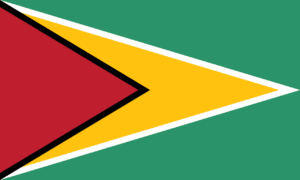Guyana | History, Capital, Language, Flag, Facts & Geography of Guyana
History of Guyana:
The country of Guyana was originally settled by the Arawak and Caribbean tribes. They named it Guiana, which means “land of many waters”. The first European settlers were the Dutch who came at the end of his 16th century. However, many years later, in 1796, the British seized power.
Guyana gained independence from Britain in 1966 and became a republic in 1970. Since then, however, the country’s political history has been somewhat tumultuous.
Get Free Counseling
Information about Guyana:
| Capital | Georgetown |
| Population | 814,715 (Source: 2023 worldometer) |
| Major Cities | Georgetown (capital), New Amsterdam, Linden, Lethem, Bartica, Anna Regina, Mabaruma, Mahdia. |
| Borders | Venezuela in west, by Brazil in south west and south, by Suriname in east, and by the North Atlantic Ocean in north east |
| Gross Domestic Product (GDP) | $15,357,537,068 (2022 worldometer) |
| Currency | Guyanese dollar (GYD) |
Flag of Guyana:
Guyana Economy Key Industries:
Guyana Major Industries: bauxite, sugar, rice milling, timber, textiles, gold mining
Guyana Agricultural Products: sugarcane, rice, wheat, vegetable oils; beef, pork, poultry, dairy products; fish, shrimp
Guyana Natural Resources: bauxite, gold, diamonds, hardwood timber, shrimp, fish
Guyana Major Exports: sugar, gold, bauxite/alumina, rice, shrimp, molasses, rum, timber
Guyana Major Imports: manufactures, machinery, petroleum, food
The Geography of Guyana:
Total Size of Guyana: 214,969 km² (source: 2022 worlddata)
Geographical Low Point of Guyana: Atlantic Ocean 0 m
Geographical High Point of Guyana: Mount Roraima 2,835 m
Climate of Guyana: Tropical; hot, humid, moderated by northeast trade winds; two rainy seasons (May to August, November to January)
General Terrain of Guyana: mostly rolling highlands; low coastal plain; savanna in south
World Region or Continent of Guyana: South America
Geographical Coordinates: 5 00 N, 59 00 W
The People of Guyana & Culture
Guyana Government Type: republic
Guyana Nationality: Guyanese (singular and plural)
Guyana National Holiday: Republic Day, 23 February (1970)
Guyana Independence: 26 May 1966 (from UK)
Guyana National Symbol:
Guyana National Anthem or Song: Dear Land of Guyana, of Rivers and Plains
Guyana Languages Spoken: English, Amerindian dialects, Creole, Hindi, Urdu
Guyana Religions: Christian 50%, Hindu 35%, Muslim 10%, other 5%
Interesting Facts about Guyana:
Guyana is a small country in northern South America, bordering Brazil, Suriname and Venezuela.
Guyana was originally inhabited by semi-nomadic Indian tribes, especially the Arawak and Carib, who were primarily hunters and fishermen.
Guyana was first discovered by Europeans by Christopher Columbus in his 1498.
A map of Guyana with neighboring countries. Guyana borders Brazil, Suriname and Venezuela
Over the centuries that followed, Guyana changed ownership many times between the European colonial powers France, the Netherlands, and Great Britain. Guyana officially became a British colony in 1831 and finally achieved full independence in 1966.
In 1620, the Dutch began importing slaves from the west coast of Africa into Guyana to work on the sugar plantations.
Guyana’s flag is known as the “Golden Arrowhead”. The five colors represent different characteristics. Green represents the jungles and fields that make up most of the land. White because there are many rivers. Red signifies enthusiasm and sacrifice in nation building. Black means patience.
After slavery was abolished in 1834, Indian, Portuguese, Chinese, and Javanese indentured laborers were brought to Guyana to work on the plantations. As a result, Guyana’s population profile is highly diverse.
Guyana is therefore known as the “Land of Six”.
Scotland was heavily involved in the slave trade during her 18th and her 19th centuries, especially in Guiana. South of Guyana’s capital, Georgetown, there are at least 30 place names associated with the Scottish Highlands. These include Alness, Veradrum, Kulcairn, Dunrobin, Glaszurich, Inverness, Quintale, Quintyre, Rosehall and Thein.
Kaieteur Falls in Guyana is the tallest waterfall in the world. The waterfall cascades down an 800-foot-high cliff and ranges in width from 250 to 400 feet, depending on the season.
In fact, Guyana has at least 300 waterfalls and several rivers, so it means “land of many waters.” Other famous waterfalls include Orinduik Falls and Marshall Falls.
In 1978, 918 people committed mass suicide in Guyana following cult leader Jim Jones, known in Guyana as the Jonestown Massacre. Guyana is the second poorest country in South America after Bolivia.
But Guyana is gearing up for an oil boom after discovering more than 5.5 billion barrels worth of oil in 2019. Oil is under the sea in this country in the Atlantic Ocean.
Guyana is the only English-speaking country in South America.
Guyana is home to many rare species, including colorful frogs, jaguars, and even a blue tarantula, which he discovered in 2017. In fact, researchers have discovered more than 30 new species this year.
